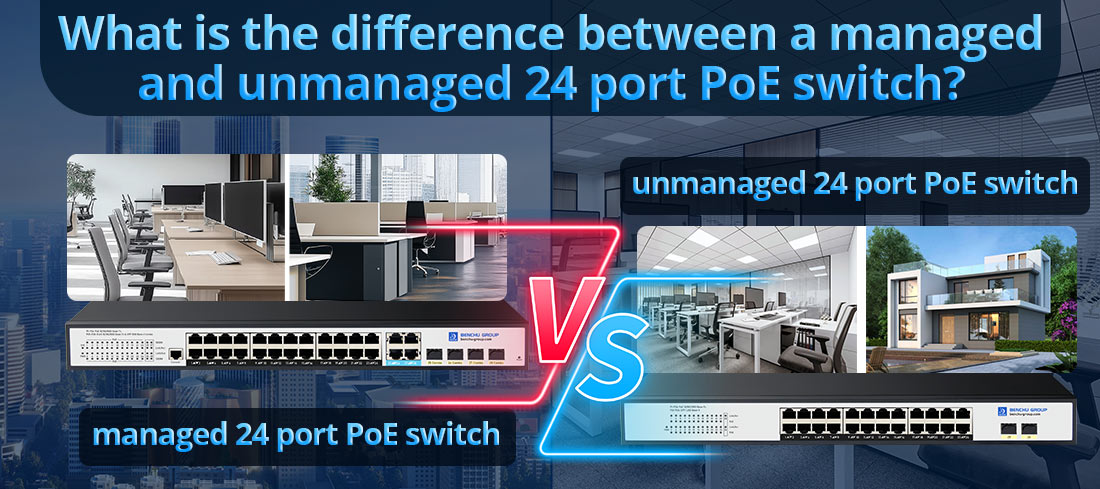
يكمن الاختلاف بين محولات PoE المُدارة وغير المُدارة ذات 24 منفذًا في وظائفها وتحكمها وميزاتها. فيما يلي وصف تفصيلي لكل نوع واختلافاته وأفضل حالات استخدامه.
1. محول PoE ذو 24 منفذًا غير مُدار
--- ان مفتاح PoE غير مُدار هو جهاز توصيل وتشغيل يوفر اتصالاً أساسيًا وتوصيل طاقة PoE دون أي خيارات تكوين متقدمة.
الميزات الرئيسية:
--- سهولة الاستخدام: ما عليك سوى توصيل أجهزتك، وسيقوم المفتاح تلقائيًا باكتشاف الأجهزة المتوافقة مع PoE وتشغيلها.
--- التكوين: لا توجد واجهة ويب أو واجهة سطر أوامر للإعداد أو الإدارة.
--- الإعدادات الثابتة: تعمل المنافذ بإعدادات محددة مسبقًا (مثل السرعة وتخصيص الطاقة وجودة الخدمة).
--- تسليم الطاقة بو: يوفر الطاقة للأجهزة المتصلة بناءً على إجمالي ميزانية PoE للمحول وحدود كل منفذ.
لا توجد ميزات الشبكات المتقدمة:
--- لا يوجد دعم VLAN.
--- لا يوجد تحديد أولويات حركة المرور.
--- لا توجد أدوات مراقبة أو استكشاف الأخطاء وإصلاحها.
المزايا:
--- فعالة من حيث التكلفة: أرخص من المفاتيح المُدارة.
--- النشر البسيط: مثالية للشبكات الصغيرة أو الإعدادات التي تتطلب الحد الأدنى من الخبرة الفنية.
--- مصداقية: الميزات الأقل تعني فرصًا أقل للتكوين الخاطئ.
أفضل حالات الاستخدام:
--- الشركات الصغيرة أو الشبكات المنزلية.
--- الشبكات ذات متطلبات PoE الأساسية (على سبيل المثال، تشغيل كاميرات IP أو هواتف VoIP أو نقاط الوصول البسيطة).
--- البيئات التي تكون فيها الميزات المتقدمة مثل التحكم في حركة المرور ومراقبتها غير ضرورية.
2. محول PoE مُدار بـ 24 منفذًا
--- أ تبديل PoE المُدار يوفر تحكمًا شاملاً في الشبكة، مما يسمح بالتكوين التفصيلي والمراقبة واستكشاف الأخطاء وإصلاحها.
الميزات الرئيسية:
خيارات التكوين المتقدمة:
--- شبكات محلية ظاهرية: قم بتقسيم الشبكة لتحسين عزل حركة المرور والأمان.
--- جودة الخدمة (جودة الخدمة): إعطاء الأولوية لحركة المرور الهامة (على سبيل المثال، VoIP، وتدفقات الفيديو).
--- تجميع الارتباط: الجمع بين منافذ متعددة لزيادة عرض النطاق الترددي.
--- انعكاس المنفذ: مراقبة منافذ محددة لاستكشاف الأخطاء وإصلاحها.
إدارة بو:
--- التحكم في الطاقة لكل منفذ: تمكين/تعطيل PoE على المنافذ الفردية.
--- جدولة الطاقة: تشغيل/إيقاف تشغيل الأجهزة تلقائيًا في أوقات محددة.
--- أولويات الطاقة: تأكد من حصول الأجهزة المهمة على الطاقة أولاً أثناء نقص الطاقة.
المراقبة واستكشاف الأخطاء وإصلاحها:
--- مراقبة حركة المرور في الوقت الفعلي (على سبيل المثال، عبر SNMP أو الواجهة المستندة إلى الويب).
--- تشخيص الأخطاء وتسجيلها.
--- الوصول عن بعد للصيانة والتحديثات.
ميزات الأمان:
--- قوائم التحكم بالوصول (ACLs).
--- أمن المنفذ لمنع الوصول غير المصرح به.
--- الحماية ضد حلقات الشبكة أو عواصف البث.
--- قابلية التوسع والمرونة: قم بتكييف المحول بسهولة لتوسيع الشبكة أو تغييراتها في المستقبل.
المزايا:
--- التحكم الكامل بالشبكة: يوفر التحكم الدقيق في حركة المرور وإدارة الطاقة.
--- زيادة الأمن: يحمي من الوصول غير المصرح به ونقاط ضعف الشبكة.
--- تحسين: يضمن الاستخدام الفعال لعرض النطاق الترددي وموارد الطاقة.
--- التدقيق في المستقبل: قابلة للتطوير للشبكات المتنامية.
أفضل حالات الاستخدام:
--- الشركات أو المؤسسات المتوسطة والكبيرة.
--- شبكات ذات أجهزة متنوعة (مثل كاميرات IP عالية الوضوح ونقاط الوصول المتقدمة وأجهزة إنترنت الأشياء).
--- البيئات التي تتطلب تجزئة حركة المرور أو تحديد الأولويات أو استكشاف الأخطاء وإصلاحها بشكل متقدم.
--- الشبكات ذات المهام الحرجة حيث يكون وقت التشغيل والأداء ضروريين.
الاختلافات الرئيسية بين محولات PoE المُدارة وغير المُدارة ذات 24 منفذًا
| ميزة | مفتاح PoE غير مُدار | تبديل PoE المُدار |
| يثبت | التوصيل والتشغيل، لا يوجد تكوين. | يتطلب التكوين الأولي. |
| يتحكم | لا يوجد تحكم المستخدم. | السيطرة الكاملة على الموانئ وحركة المرور والطاقة. |
| دعم شبكة محلية ظاهرية | غير متوفر. | يدعم تجزئة VLAN. |
| إدارة حركة المرور | لا أحد. | جودة الخدمة، التحكم في عرض النطاق الترددي، تجميع الروابط. |
| إدارة بو | تخصيص الطاقة التلقائي فقط. | التحكم في الطاقة لكل منفذ، والجدولة، وتحديد الأولويات. |
| يراقب | لا توجد أدوات المراقبة. | المراقبة في الوقت الحقيقي، SNMP، والتسجيل. |
| حماية | الحد الأدنى (وظيفة المنفذ الأساسية). | ميزات الأمان المتقدمة (قوائم التحكم بالوصول (ACL)، أمان المنفذ). |
| يكلف | أدنى. | أعلى. |
| حالات الاستخدام | شبكات صغيرة وبسيطة. | شبكات كبيرة أو معقدة أو متنامية. |
كيفية الاختيار بين المدارة وغير المدارة 24 منفذ بو إي إي
اختر مفتاحًا غير مُدار إذا:
--- أنت بحاجة إلى حل فعال من حيث التكلفة لشبكة بسيطة.
--- تحتوي الشبكة على أجهزة أساسية لا تتطلب تجزئة حركة المرور أو تحديد الأولويات.
--- تفضل الحد الأدنى من الإعداد دون خبرة فنية.
اختر محولاً مُدارًا إذا:
--- تتطلب شبكتك متطلبات معقدة، مثل شبكات VLAN أو جودة الخدمة.
--- أنت بحاجة إلى تحكم ومراقبة مركزية للأجهزة وحركة المرور.
--- يعد الأمان وقابلية التوسع أمرًا بالغ الأهمية لشبكتك.
--- لديك موارد تكنولوجيا المعلومات أو الخبرة اللازمة للإعداد والصيانة.
خاتمة
--- منفذ 24 منفذًا غير مُدار التبديل بو مثالي للشبكات الصغيرة أو الأساسية ذات المتطلبات الدنيا.
--- يعد محول PoE المُدار ذو 24 منفذًا هو الأفضل للشبكات أو البيئات المتوسطة إلى الكبيرة التي تتطلب المرونة والتحكم والميزات المتقدمة.
من خلال الأخذ في الاعتبار مدى تعقيد شبكتك واحتياجات قابلية التوسع والموارد المتاحة، يمكنك تحديد المحول الذي يتوافق بشكل أفضل مع أهدافك.